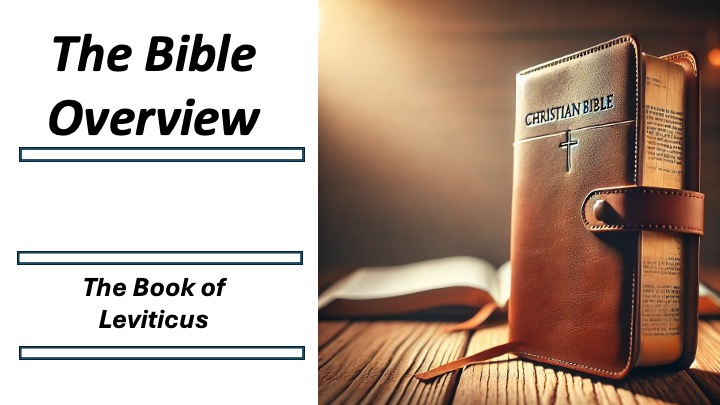Bible Overview Leviticus
Mike Ervin

Leviticus is a fascinating book, often overlooked but central to understanding Israel’s covenant relationship with God. A structured breakdown follows:
1. Introduction to Leviticus
• Title & Meaning: Derived from the Greek Leuitikon (related to the Levites), but primarily directed to the priesthood and the people.
• Placement in the Bible: Third book of the Torah/Pentateuch, following Exodus.
• Connection to Exodus: After building the Tabernacle, Leviticus provides the laws for maintaining holiness in worship and daily life.
2. Authorship & Date
• Traditional View: Moses, as part of the Torah (Leviticus 1:1; 27:34).
• Historical Context: Likely written during Israel’s wilderness period (c. 1446–1406 BC if following the early Exodus date; or c. 1250 BC if following the late Exodus date).
• Scholarly Perspectives: Some scholars suggest it was finalized in the post-exilic period (5th century BC) based on linguistic and thematic analysis.
3. Intended Audience
• Israelites as a whole: Instructions for national holiness.
• Priests (Levites and Aaronic line): Specific laws on sacrifices, purity, and worship.
• Future Generations: A guide for maintaining covenantal purity and worship.
4. Major Themes
• Holiness: “Be holy, for I am holy” (Leviticus 11:44-45; 19:2).
• Sacrificial System: Blood atonement as a means of reconciliation (Leviticus 17:11).
• Priesthood & Worship: Mediators between God and people.
• Purity Laws: Clean vs. unclean distinctions in food, behavior, and disease.
• Atonement: The Day of Atonement (Yom Kippur) as the central ritual (Leviticus 16).
• Covenantal Obedience: Blessings for obedience and curses for disobedience (Leviticus 26).
5. Sequential Overview of Chapters
A. Sacrificial Laws (Chapters 1–7)
• Burnt Offering (Ch. 1) – Total dedication to God.
• Grain Offering (Ch. 2) – Worship and thanksgiving.
• Peace Offering (Ch. 3) – Fellowship with God.
• Sin Offering (Ch. 4–5) – Atonement for unintentional sin.
• Guilt Offering (Ch. 5–6) – Restitution and forgiveness.
• Priestly duties in offerings (Ch. 6–7).
B. Consecration of the Priesthood (Chapters 8–10)
• Ordination of Aaron and his sons (Ch. 8).
• Priestly ministry begins (Ch. 9).
• Judgment of Nadab & Abihu (Ch. 10).
C. Laws on Purity (Chapters 11–15)
• Clean and unclean animals (Ch. 11).
• Purity laws for childbirth (Ch. 12).
• Laws on leprosy and skin diseases (Ch. 13–14).
• Bodily discharges and purification (Ch. 15).
D. The Day of Atonement (Chapter 16)
• High priest enters the Holy of Holies.
• Scapegoat ceremony.
• Blood sprinkled for national atonement.
E. Holiness Laws (Chapters 17–26)
• Proper handling of blood (Ch. 17).
• Moral and sexual purity (Ch. 18).
• Ethical holiness laws (Ch. 19).
• Consequences of sin and idol worship (Ch. 20).
• Priestly holiness (Ch. 21–22).
• Sacred festivals and Sabbaths (Ch. 23–25).
• Covenant blessings and curses (Ch. 26).
F. Vows and Dedications (Chapter 27)
• Regulations on vows and offerings to God.
6. Conclusion
• Leviticus’ Relevance Today:
• Highlights God’s holiness and our call to holiness.
• Foreshadows Christ’s atonement (Hebrews 9–10).
• Provides a foundation for biblical ethics and worship.